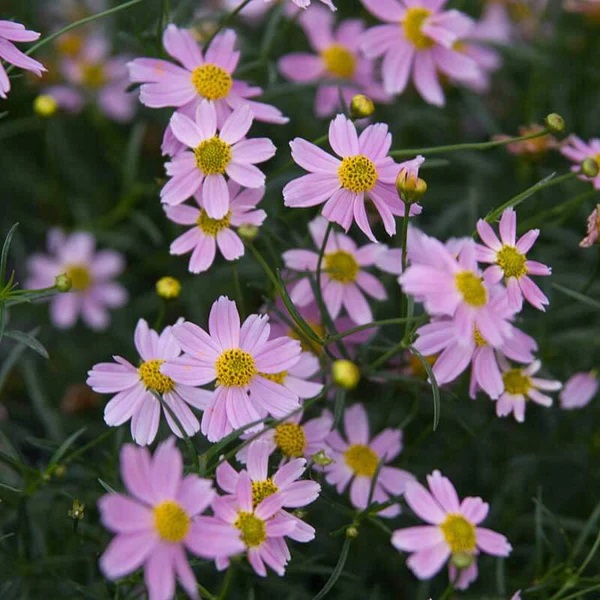Saponaria

Botanical Name: Coreopsis
Category: perennial
Divisible: Yes
Common Name: Tickseed
Evergreen: No
Propagation: Division, seed or cutting
Family: Asteraceae (Sunflowers)
Invasive: No
Size: 18-24″” tall x 12″-18″ wide
Coreopsis is prized by many gardeners for their bright colors and their adaptability. There are many species, and hybrids and both perennials and annual varieties.
Most are drought tolerant, can handle poor soil and have a long bloom time – from summer til fall. Deadheading will prolong their bloom time.
Sun loving they can tolerate poor, sandy and rocky soil.
Coreopsis rosea is a notable and popular species – and my favorite! Masses of rose-pink, daisy-like flowers are dotted with golden yellow centers among soft fern-like foliage. And they attract butterflies and bees.


My Experience:
One of my favorites and such a delicate plant that actually grows in a high desert garden. I have very good luck with coreopsis rosea and a yellow variety – coreopsis verticillata or threadleaf coreopsis.
Be sure to deadhead on a regular basis to keep them blooming. This can really be a chore as their blossoms are myriad and tiny! I must admit that sometimes I will grab a clump and shear off the tops.
Growing from Seed:
Coreopsis Rosea is easy to grow from seed and does not require a period of cold stratification. Seeds can be sown directly into the garden or started indoors and bloom in their second year. Please note Coreopsis seeds need light to germinate.
Once established gather seeds in the fall for propagation. To collect them, pinch the dead blooms off the plant and allow them to dry in a cool, dark place. The seeds are ready to sow when you shake the dead bloom and hear the seeds rattling inside.
Direct Sowing:
Directly sow Coreopsis seeds outdoors in spring into a prepared seed bed.
Remove weeds and work organic matter into the top 6-8” of soil; then level and smooth.
Press the Coreopsis flower seed into the soil but do not cover it. Firm lightly and keep evenly moist until germination.
Seedlings will emerge in 14-28 days depending on soil and weather conditions
Thin to about 18” apart when seedlings are 2” tall.
Indoor Start
Sow seeds into a sterile starter mix in seed trays and then press into soil. Do not cover.
Keep soil moist and at a temperature of at least 65F degrees
Under proper conditions, the seeds will germinate in 14-28 days
Once all danger of frost has passed, the established seedlings can be transplanted into the garden or pots.
Propagating by division
Divide tickseed plants every three to four years. This is best done in the early spring before new growth begins. Lift the clumps from the ground carefully and shake off lose soil. Use a knife to cut the crown into sections, making sure each section has roots. Replant the new sections in the same soil, light and temperature environment as the mother plant. Final spacing for plants is 12 inches apart.
Buy Coreopsis Rosea seeds from my Etsy shop

0 Comments